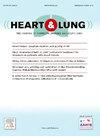西班牙多维疲劳量表在心脏病患者中的心理测量特性。
IF 2.4
4区 医学
Q2 CARDIAC & CARDIOVASCULAR SYSTEMS
引用次数: 0
摘要
背景:疲劳是心脏病(HD)患者最具限制性的症状之一。然而,在临床实践中,评估疲劳的有效和可靠的工具仍然需要改进。目的:评价西班牙多维疲劳量表(MFI)的维度结构,分析其在HD患者中的心理测量特征。方法:纵向观察研究纳入247名参与者(年龄57.71岁;女性占23.9%;89.9%高加索人)。在第一次评估后10-14天评估重测信度。收集评估疲劳、健康相关生活质量(HRQoL)和功能能力的措施来评估收敛效度。可接受性、实用性、结构效度、地板/天花板效应、内部一致性和测量误差也进行了计算。结果:验证性因子分析支持MFI的4因素结构,并删除3个项目用于HD个体。17项版本不存在下限-上限效应,具有良好的内部一致性(Cronbach’s α = 0.90)和重测信度(class内相关系数(ICC) = 0.94)。虽然所有子量表都表现出足够的内部一致性(Cronbach's α > 0.70)和良好至优异的测试-重测信度(ICC, 0.75 - 0.91),但减少动机子量表的内部一致性略低。最小的可检测变化为总分9.5分。通过与疲劳、HRQoL和功能能力测量的中强相关性(r = |0.320-0.729|)建立了聚合效度。结论:缩短版的西班牙MFI (MFI-17)是量化HD患者疲劳的有效和可靠的工具,支持其临床和研究适用性。本文章由计算机程序翻译,如有差异,请以英文原文为准。
Psychometric properties of the Spanish Multidimensional Fatigue Inventory in people with heart diseases
Background
Fatigue is one of the most limiting symptoms in individuals with heart disease (HD). However, valid and reliable instruments for assessing fatigue in clinical practice still need to be improved.
Objective
To assess the dimensional structure of the self-reported Spanish Multidimensional Fatigue Inventory (MFI) and analyze its psychometric properties in individuals with HD.
Methods
A longitudinal observational study included 247 participants (age 57.71 years; 23.9 % women; 89.9 % Caucasian). Test-retest reliability was assessed 10–14 days after the first evaluation. Measures evaluating fatigue, health-related quality of life (HRQoL), and functional capacity were collected to assess convergent validity. Acceptability, practicality, construct validity, floor/ceiling effects, internal consistency, and measurement error were also calculated.
Results
Confirmatory factor analysis supported the 4-factor structure of the MFI and the deletion of 3 items for its application in individuals with HD. The 17-item version showed no floor-ceiling effects and exhibited excellent internal consistency (Cronbach's α = 0.90) and test-retest reliability (Intraclass Correlation Coefficient (ICC) = 0.94). While all subscales demonstrated adequate internal consistency (Cronbach's α > 0.70) and good to excellent test-retest reliability (ICC, 0.75 - 0.91), the reduced motivation subscale showed slightly lower internal consistency. The minimal detectable change was 9.5 points for the total score. Convergent validity was established through moderate-strong correlations with fatigue, HRQoL, and functional capacity measures (r = |0.320–0.729|).
Conclusions
The shortened version of the Spanish MFI (MFI-17) is a valid and reliable tool for quantifying fatigue in individuals with HD, supporting its clinical and research applicability.
求助全文
通过发布文献求助,成功后即可免费获取论文全文。
去求助
来源期刊

Heart & Lung
医学-呼吸系统
CiteScore
4.60
自引率
3.60%
发文量
184
审稿时长
35 days
期刊介绍:
Heart & Lung: The Journal of Cardiopulmonary and Acute Care, the official publication of The American Association of Heart Failure Nurses, presents original, peer-reviewed articles on techniques, advances, investigations, and observations related to the care of patients with acute and critical illness and patients with chronic cardiac or pulmonary disorders.
The Journal''s acute care articles focus on the care of hospitalized patients, including those in the critical and acute care settings. Because most patients who are hospitalized in acute and critical care settings have chronic conditions, we are also interested in the chronically critically ill, the care of patients with chronic cardiopulmonary disorders, their rehabilitation, and disease prevention. The Journal''s heart failure articles focus on all aspects of the care of patients with this condition. Manuscripts that are relevant to populations across the human lifespan are welcome.
 求助内容:
求助内容: 应助结果提醒方式:
应助结果提醒方式:


